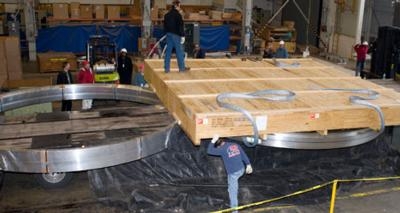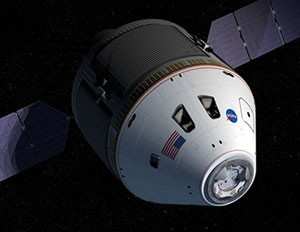But The First Flight Is Still More Than A Year In The Future
Recent engineering advances by NASA and its industry partners across the country show important progress toward Exploration Flight Test-1 (EFT-1), the next step to launching humans to deep space. The uncrewed EFT-1 mission, launching from NASA's Kennedy Space Center in Florida in 2014, will test the re-entry performance of the agency's Orion capsule.

"These recent milestones are laying the foundation for our first flight test of Orion in 2014," said Dan Dumbacher, deputy associate administrator for exploration systems development at NASA Headquarters in Washington. "The work being done to prepare for the flight test is really a nationwide effort and we have a dedicated team committed to our goal of expanding the frontier of space."
A tool that will allow the titanium skeleton of the Orion heat shield to be bolted to its carbon fiber skin is at the Denver facility of the spacecraft's prime contractor Lockheed Martin (pictured). This will enable workers to begin assembling the two pieces of the heat shield. Almost 3,000 bolts are needed to hold the skeleton to the skin. A special stand was built to align the skin on the skeleton as holes for the bolts are drilled. Work to bolt the skeleton to the skin will be completed in January. The heat shield then will be shipped to Textron Defense Systems near Boston where the final layer, an ablative material very similar to that used on the Apollo spacecraft, will be added. The completed heat shield is scheduled to be ready for installation onto the Orion crew module at Kennedy next summer.
To test the heat shield during EFT-1's re-entry, Orion will travel more than 3,600 miles above Earth's surface, 15 times farther than the International Space Station's orbital position. This is farther than any spacecraft designed to carry humans has gone in more than 40 years. Orion will return home at a speed almost 5,000 mph faster than any current human spacecraft.
This week, engineers at NASA's Marshall Space Flight Center in Huntsville, AL, received materials to begin manufacturing the adapter that will connect the Orion capsule to a United Launch Alliance Delta IV heavy-lift rocket for EFT-1. Two forward and two aft rings will be welded to barrel panels to form two adapters. This adapter design will be tested during EFT-1 for use during the first launch of NASA's next heavy-lift rocket, the Space Launch System (SLS), in 2017. SLS will launch NASA's Orion spacecraft and other payloads beyond low Earth orbit, providing an entirely new capability for human exploration. Data from the adapter on the flight test will provide Marshall engineers with invaluable experience developing hardware early in the design process. Designing the adapter once for multiple flights also provides a cost savings. Of the two adapters welded at Marshall, one will attach Orion to the Delta IV heavy-lift rocket used for EFT-1. The other adapter will be a structural test article to gain
knowledge on the design.

NASA's Ground Systems Development and Operations (GSDO) Program also has passed a major agency review that lays the groundwork at Kennedy to support future Orion and SLS launches. The GSDO Program completed a combined system requirements review and system definition review, in which an independent board of technical experts from across NASA evaluated the program's infrastructure specifications, budget and schedule. The board confirmed GSDO is ready to move from concept development to preliminary design. The combination of the two assessments represents a fundamentally different way of conducting NASA program reviews. The team is streamlining processes to provide the nation with a safe, affordable and sustainable launch facility.
The GSDO program last week also led the third Stationary Recovery Test Working Group session in Norfolk, Va. The team presented to the U.S. Navy detachment that will recover the capsule during EFT-1 a complete list of tasks required to accomplish stationary recovery test objectives. The working group outlined the plan for roles and responsibilities to accomplish required test procedures. Included in these presentations were the commanding officer of the USS Mesa Verde and the fleet forces command director of operations, who both expressed complete support for the test.
(Images provided by NASA)
 Senator Pushes FAA to Accelerate Rocket Launch Licensing
Senator Pushes FAA to Accelerate Rocket Launch Licensing Classic Aero-TV: RJ Gritter - Part of Aviations Bright New Future
Classic Aero-TV: RJ Gritter - Part of Aviations Bright New Future Aero-FAQ: Dave Juwel's Aviation Marketing Stories -- ITBOA BNITBOB
Aero-FAQ: Dave Juwel's Aviation Marketing Stories -- ITBOA BNITBOB ANN's Daily Aero-Linx (10.27.24)
ANN's Daily Aero-Linx (10.27.24) ANN's Daily Aero-Term (10.27.24): Clearance Void If Not Off By (Time)
ANN's Daily Aero-Term (10.27.24): Clearance Void If Not Off By (Time)




